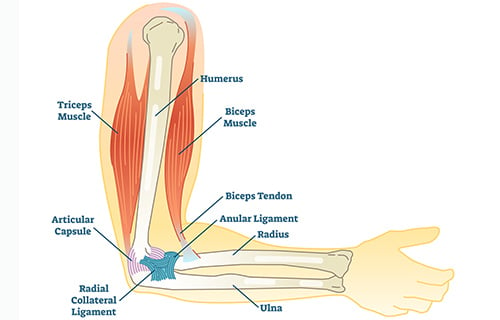Elbow Pain, Conditions and Treatments
When people think about performing manual tasks, the hands and wrists are what usually come to mind. But without the elbow, so much of what we do each day would be impossible. The elbow governs the placement of your hand in space. When your elbow is in pain, injured, stiff, or unstable, your quality of life can be significantly impaired.
Overview of the elbow
Learning about the anatomy of the elbow joint can help you better understand how it works and how you can best preserve its function and comfort for years to come.
The elbow is the joint composed of the end of the upper arm bone, called the humerus, and the two forearm bones: the radius and ulna. Your "funny bone" is the protrusion at the end of the ulna known as the olecranon. The joint is stabilized by ligaments at the front, back, and sides of the elbow. Muscles and tendons in the joint enable you to bend and straighten your arm and to rotate the forearm without moving the upper arm. The ulnar nerve runs through the elbow and into the forearm, along with a network of vital blood vessels.

Elbow injuries
When your elbow hits a surface after your body has been speeding through space – such as falling from a bike or scooter or on a basketball court – you may sustain a fracture of the ulna or radius bones of the upper arm, a dislocation (where the elbow bones come out of alignment), or a tear of the soft tissues that surround the bones. Falling on an icy sidewalk or from a high height off a ladder as you are trying to clean out your gutters at home are other common causes of elbow injuries.
An injury to the elbow can cause swelling, pain, instability and decreased range of motion. Depending on your injury, you may need a splint and sling to immobilize the arm while you heal, combined with a program of physical therapy. If surgery is needed, your doctor will discuss your options. Surgery can range from repairing torn tendons and ligaments and releasing scar tissue to increase range of motion to replacing the entire joint. Your recovery depends on the extent of your injury and your commitment to your therapy exercises.
The risk of severe elbow injury is elevated in older people, who are more active now than our older population was years ago, so doctors are seeing more of them coming in with elbow trauma. As the population ages and people who have had a total elbow replacement surgery are living longer, research is under way to develop more durable replacement joints that last longer than existing models.
An elbow injury is the most common reason why a person would need elbow replacement surgery (severe cases of rheumatoid arthritis come in second). If you need an elbow replacement, try to locate an orthopedic surgeon who is an upper extremity specialist and who does this procedure several times a year. It can be challenging, however, to find an appropriate elbow specialist in some areas.
Stiff elbow
Stiff elbow may develop after a fracture, dislocation, or other injury, elbow surgery or osteoarthritis. The build-up of scar tissue and formation of bony tissue around the joint make it difficult to bend (flex) and straighten (extend) your arm completely. Stiff elbow doesn't typically cause pain, but you may find it difficult to do routine activities such as brushing your hair or putting your hand to your mouth to eat. Stiff elbow is not something you have to live with. There are several treatment options to get you moving again.
Your doctor may first prescribe physical therapy to increase the range of motion. If after a few months you hit a plateau and your range of motion is still not what it should be, you may need surgery. During the operation, the orthopedic surgeon will remove the scar and bone tissue that is interfering with elbow movement. You'll likely stay in the hospital for one to two days for pain control, and you'll be visited by a physical therapist to start your rehabilitation. Your therapy may also include a "continuous passive motion" (CPM) machine, which gently bends and extends your elbow for you. You'll continue your physical therapy for several weeks afterward as well.
You can expect to wear a variety of splints during your recovery: a resting splint that keeps your elbow bent at 90º, a "come-along" splint to promote elbow flexion, and another extension splint to help you stretch your elbow. You'll receive instructions about how much you need to wear each splint each day. Expect to take up to three months to fully recover from the surgery, and when you do, you'll be glad you did it. Having the initial operation done by a surgeon with advanced training in elbow procedures will give you the greatest chance of a smooth recovery and reduce the need for another operation.
Elbow instability
The most common cause of elbow instability is a dislocation. A dislocated elbow can damage the arteries and nerves in the arm, which can interfere with movement and sensation. It is vital to see a doctor quickly after an elbow dislocation in order to have the damage assessed and get the joint realigned properly. Physical therapy for this injury includes a method called the "overhead motion" protocol, which will promote healing and achieve optimal joint health. A simple dislocation usually requires physical therapy and the wearing of a splint for three to four weeks, with full recovery often achieved by six weeks after the dislocation.
An accurate diagnosis to gauge the extent of the injury is the most important part of treating elbow instability. Surgery may be done to repair torn ligaments or damaged arteries and nerves, followed by physical therapy and full recovery in three to six months. If there is a fracture in addition to the dislocation, orthopedic surgery may be needed to repair the broken bone as well as any torn ligaments.
An undiagnosed fracture combined with an elbow dislocation may cause the elbow to start to heal inappropriately. This can result in stiffness that may later require one or more complex surgical operations to literally take apart and reconstruct the elbow, followed by a lengthy rehabilitation. The sooner you receive the most effective care for elbow instability, the sooner you will be on the road to recovery.
Keeping your elbows healthy
If you experience an injury or other problems with your elbow, see an orthopedic specialist early – preferably one with advanced training in elbow care – to diagnose the problem accurately so you can start effective treatment as soon as possible. The elbow is a delicate joint, with an intricate network of nerves and blood vessels that need to be carefully navigated around during surgery. Finding an appropriate elbow specialist will give you the best chance of a successful recovery.
Elbow and Arm Injuries and Conditions Success Stories
Medically reviewed by Aaron Daluiski, MD ; Robert N. Hotchkiss, MD

